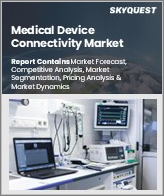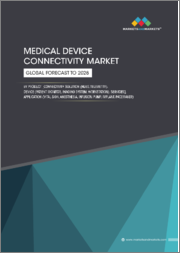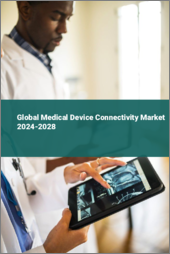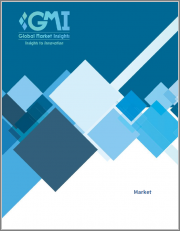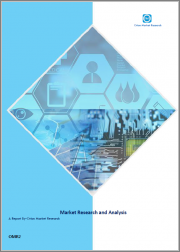
|
시장보고서
상품코드
1444403
의료기기 커넥티비티 : 시장 점유율 분석, 업계 동향과 통계, 성장 예측(2024-2029년)Medical Device Connectivity - Market Share Analysis, Industry Trends & Statistics, Growth Forecasts (2024 - 2029) |
||||||
의료기기 커넥티비티 시장 규모는 2024년에 31억 6,000만 달러로 추정되며, 2029년까지 91억 7,000만 달러에 달할 것으로 예측되고 있으며, 예측 기간(2024-2029년) 중 23.74%의 CAGR로 성장합니다.
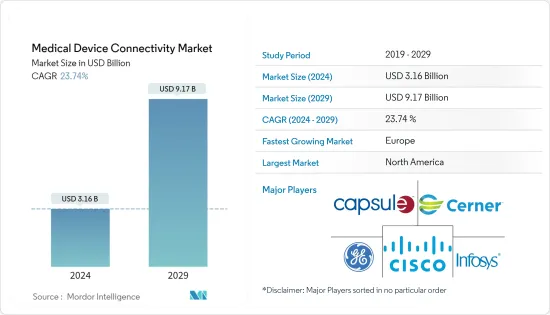
의료기기 커넥티비티는 감염으로 인해 많은 환자가 입원하는 등 COVID-19 감염병 사태로 인해 긍정적인 영향을 받은 산업 중 하나입니다. 예를 들어 De Gruyter가 2021년 8월에 발표한 기사에 따르면 의료 사물인터넷(IoMT) 기술의 발전으로 모든 의료 툴, 의료 데이터베이스 및 장비가 인터넷을 통해 하나의 협업 네트워크로 연결될 수 있게 되어 실시간 데이터 통합 및 분석이 가능해졌습니다. 데이터 통합 및 분석. IoMT 프레임 워크를 활용하는 COVID-19 자체 평가 툴은 여러 세부 질문을 통해 징후와 증상을 포착하고 데이터를 COVID-19 환자 데이터베이스에 저장하고 데이터를 분석하여 해당 사람이 COVID-19 또는 기타 검사를 받아야하는지 여부를 결정합니다. 조치를 취해야 할 수도 있습니다. 조치를 취해야 할 수도 있습니다. 의료기기 커넥티비티 시스템은 대유행 기간 중 건강 결과를 개선하고 혼란을 줄이는 능력을 입증했으며 병원은 수동 시스템보다 의료기기 커넥티비티 시스템의 이점을 인식하게되었습니다. 따라서 의료기기 커넥티비티 시스템에 대한 수요가 증가하여 궁극적으로 시장 성장을 주도했습니다.
시장 성장의 주요 요인으로는 전자 건강 기록 및 건강 정보 교환 시스템의 도입 증가, 원격의료 및 원격의료 기술에 대한 수요 증가, 무선 기술 및 블루투스 지원 의료기기의 기술 발전이 있습니다. 예를 들어 Cox Communications, Inc.가 2022년 5월에 발표 한 기사에 따르면 Bluetooth Low Energy(BLE)가 개발되어 추적에 Bluetooth 기술이 사용되었습니다. BLE는 휴대폰 및 기타 장비를 통해 소프트웨어와 게이트웨이를 사용합니다. 저전력 무선 기술을 실현하고 장비 간 통신을 가능하게 하면서 배터리 수명을 연장할 수 있습니다. 대부분의 스마트폰과 태블릿은 BLE를 지원하므로 긴밀한 연락에 적합합니다. 또한 2021년 9월 영국 왕립생식보건학부(FSRH)와 영국 왕립산부인과의사회(RCOG)는 조기 약물 낙태(EMA) 원격의료에 대한 정보를 전파하는 새로운 캠페인을 시작했습니다. 따라서 원격의료 서비스 도입률 증가는 의료기기 커넥티비티 시장의 성장에 직접적인 영향을 미치고 있습니다.
양사는 그 기반을 확대하기 위해 신제품 출시 개발 및 협업에 적극적으로 나서고 있습니다. 예를 들어 로얄 Philips는 2021년 10월 통합과 상호운용성을 가능하게 하는 디바이스 촉진제인 Philips 캡슐 MDIP(Philips Capsule Medical Device Information Platform, MDIP)를 출시했습니다. Philips 캡슐 MDIP는 전 세계 3,000개 이상의 의료시설에 설치된 Philips 헬스스위트(Philips HealthSuite) 플랫폼에 통합되어 있습니다. Philips 캡슐 MDIP는 스트리밍 임상 데이터를 캡처하고 이를 환자 치료 관리를 위한 실용적인 인사이트으로 전환하여 의료진 간의 협업을 개선하고 임상 워크플로우를 간소화하며 생산성을 향상시키는 것을 목표로 합니다. 이러한 발전은 예측 기간 중 시장 성장을 가속할 것으로 예상됩니다.
따라서 위의 요인들이 종합적으로 예측 기간 중 조사 대상 시장의 성장에 기여할 것으로 예상됩니다. 그러나 높은 배포 및 전체 설치 비용과 고급 솔루션의 도입 제한으로 인해 예측 기간 중 시장 성장이 저해될 것으로 예상됩니다.
의료기기 커넥티드 시장 동향
무선 기술 부문 기술별로는 예측 기간 중 큰 폭의 성장이 예상됩니다.
무선 기술에는 의료기기 제어 및 프로그래밍, 환자 원격 모니터링, 의료기기에서 휴대폰과 같은 다른 플랫폼으로 환자 데이터 전송 등이 포함됩니다. 시장 성장을 가속하는 주요 요인으로는 기술 발전 증가와 의료 시설에서 무선 의료기기 커넥티비티의 채택 증가가 있습니다. 예를 들어 의료기기의 무선 주파수 무선 기술과 블루투스 저에너지(Bluetooth Low Energy, BLE)는 안전하고 효과적인 무선 의료기기를 개발하고 지원하기 위한 권장 사항을 제공합니다. 의료기기 제조업체는 이 가이드를 읽고 관련 인증 표준 및 지침 문서를 검토하여 무선 지원 의료기기의 개발, 테스트, 규제 제출 및 사용에 도움이 될 수 있도록 관련 인증 표준 및 지침 문서를 검토하는 것이 좋습니다. 예를 들어 RFiD Discovery 2022에 따르면 의료기기의 고유 기기 식별 시스템은 미국 FDA의 고유 기기 식별(UDI) 규정에 따라 의무화되어 있습니다. 즉, 미국에서 사용되는 모든 의료기기는 사람과 기계가 모두 읽을 수 있는 고유 기기 식별자(UDI)를 부착해야 합니다. 첨단 기술에 대한 수요가 시장의 무선 기술 분야를 자극하고 있습니다.
또한 양사는 무선 기술 분야에서의 확장을 확대하기 위해 신제품 출시 개발 및 협업에 적극 나서고 있습니다. 예를 들어 CareVention Healthcare는 2021년 9월 바이오 센서와 인공지능을 사용하여 환자의 활력 징후를 모니터링하고 필요한 경우 의료 서비스 프로바이더에게 경고하는 원격 환자 모니터링 서비스를 시작했습니다.
따라서 위의 요인들은 예측 기간 중 시장의 부문별 성장을 가속할 것으로 예상됩니다.
북미는 예측 기간 중 상당한 시장 점유율을 유지할 것으로 예상
북미에서는 만성질환의 부담 증가와 첨단 의료기술의 보급으로 인해 의료기기 커넥티비티가 헬스케어의 한 컴포넌트로 빠르게 성장하고 있습니다. 원격의료의 도입은 의료 관리, 환자의 삶의 질을 향상시키고 의료 비용을 절감했습니다. 예를 들어 캐나다 보건 정보 연구소의 2021년 보고서에 따르면 캐나다의 의료비 지출은 2020년 3,015억 달러에서 2021년 3,081억 달러로 증가했습니다. 마찬가지로 메디케어 및 메디케이드 서비스 센터(CMS)의 2022년 보고서에 따르면 미국의 의료 지출은 약 4조 3,000억 달러로 전년 대비 약 1,730억 달러 증가했습니다. 따라서 의료비 지출 증가는 원격의료에 대한 기회를 창출하여 시장 성장을 가속할 것으로 예상됩니다.
또한 정부와 기업은 의료기기 커넥티드 시장에서의 혁신과 구상을 통해 예측 기간 중 성장을 가속하고 있습니다. 예를 들어 2021년 10월 FDA의 디지털헬스센터(DHCoE)는 인공지능/머신러닝 지원 의료기기의 투명성에 대한 공개 워크숍을 개최했습니다. 이 워크숍은 최근 공개된 약 350개의 AI/ML 지원 의료기기 리스트에 따라 진행되었습니다. 이번 워크숍은 "책임감 있고 고품질의 디지털 의료 혁신을 촉진하여 이해관계자들이 의료를 발전시킬 수 있도록 돕는 것"이라는 FDA DHCoE의 목표를 진전시키는 것을 목표로 했습니다.
따라서 위의 요인을 고려할 때, 원격의료 시장은 예측 기간 중 북미에서 크게 성장할 것으로 예상됩니다.
의료기기 커넥티비티 산업 개요
의료기기 커넥티비티 시장은 세계 및 지역적으로 사업을 운영하는 여러 기업이 존재하기 때문에 본질적으로 통합된 시장입니다. 경쟁 구도에는 Capsule Technologies, Inc., Cerner Corporation, Cisco Systems, GE Healthcare, Ihealth Lab, Infosys, Koninklijke Philips NV, Lantronix, Inc, NantHealth, Inc. 등이 포함됩니다.
기타 혜택
- 엑셀 형식의 시장 예측(ME) 시트
- 3개월간의 애널리스트 지원
목차
제1장 서론
- 조사의 전제조건과 시장의 정의
- 조사 범위
제2장 조사 방법
제3장 주요 요약
제4장 시장 역학
- 시장 개요
- 시장 촉진요인
- 전자건강기록과 의료정보교환 시스템의 도입 증가
- 원격의료 및 원격의료 기술의 수요 증가
- 무선 기술과 Bluetooth 대응 의료기기의 기술 진보
- 시장 억제요인
- 도입과 완전한 인스톨에 고액의 비용이 들기 때문에 첨단 솔루션의 도입이 제한된다.
- 데이터 프라이버시와 보안에 관한 우려
- Porter's Five Forces
- 신규 진출업체의 위협
- 구매자의 교섭력
- 공급 기업의 교섭력
- 대체품의 위협
- 경쟁 기업간 경쟁의 강도
제5장 시장 세분화
- 제품과 서비스별
- 의료기기 커넥티비티 솔루션
- 의료기기 커넥티비티 서비스
- 기술별
- 유선 기술
- 무선 기술
- 하이브리드 기술
- 최종사용자별
- 병원
- 외래 진료 센터
- 기타
- 지역
- 북미
- 미국
- 캐나다
- 멕시코
- 유럽
- 독일
- 영국
- 프랑스
- 이탈리아
- 스페인
- 기타 유럽
- 아시아태평양
- 중국
- 일본
- 인도
- 호주
- 한국
- 기타 아시아태평양
- 중동 및 아프리카
- GCC
- 남아프리카공화국
- 기타 중동 및 아프리카
- 남미
- 브라질
- 아르헨티나
- 기타 남미
- 북미
제6장 경쟁 구도
- 기업 개요
- Capsule Technologies, Inc.
- Cerner Corporation
- Cisco Systems
- GE Healthcare
- Ihealth Lab
- Infosys Limited
- Koninklijke Philips NV
- Lantronix, Inc.
- NantHealth, Inc.
제7장 시장 기회와 향후 동향
KSA 24.03.18The Medical Device Connectivity Market size is estimated at USD 3.16 billion in 2024, and is expected to reach USD 9.17 billion by 2029, growing at a CAGR of 23.74% during the forecast period (2024-2029).

Medical device connectivity is one of the industries that had a positive impact due to the COVID-19 pandemic owing to the extensive patient pool getting admitted to the hospital due to the infection. For instance, according to an article published by De Gruyter, in August 2021, Advances in the internet of medical things (IoMT) technology allow to connect of all medical tools, medical databases, and devices via the internet in one collaborative network, which conveys real-time data integration and analysis. IoMT framework-driven COVID-19 self-assessment tool captured signs and symptoms through multiple probing questions, storing the data in the COVID-19 patient database, then analyzing the data to determine whether a person needs to be tested for COVID-19 or other actions may require to be taken. Medical device connectivity system has demonstrated the ability to enhance health outcomes and reduce chaos during the pandemic, which made hospitals realize the advantage of medical device connectivity system over manual systems. Hence, the demand for medical device connectivity system systems increased, eventually driving the market growth.
The major factors for the growth of the market include the rising implementation of electronic health records and health information exchange systems, an increase in the demand for telehealth and telemedicine technologies, and technological advancements in wireless technologies and Bluetooth-enabled medical devices. For instance, according to an article published by Cox Communications, Inc., in May 2022, Bluetooth Low Energy (BLE) was developed and used Bluetooth technology to track. BLE makes use of software and gateways via cell phones and other devices. It enables low-power wireless technology, extending battery life while allowing devices to communicate with one another. The vast majority of smartphones and tablets are BLE compatible, making them perfect for closer contact. Furthermore, in September 2021, the Faculty of Sexual and Reproductive Healthcare (FSRH) and the Royal College of Obstetricians and Gynecologists (RCOG) joined forces to launch a new campaign to disseminate information about telemedicine for early medical abortion (EMA). Thus, the increasing adoption rate of telemedicine services is directly affecting the growth of the medical device connectivity market.
The companies are actively involved in new product launch developments and collaborations to expand their footprint. For instance, in October 2021, Royal Philips launched device drivers that enable integration and interoperability, Philips Capsule Medical Device Information Platform (MDIP). Philips Capsule MDIP integrated into the Philips HealthSuite Platform, installed in more than 3,000 healthcare facilities globally. Philips Capsule MDIP captures streaming clinical data and transforms it into actionable insights for patient care management, aiming to improve collaboration between care teams, streamline clinical workflows, and increase productivity. Such development is expected to drive the growth of the market over the forecast period.
Therefore, the factors mentioned above are attributed collectively to the studied market growth over the forecast period. However high cost of deployment and complete installation limiting the adoption of advanced solutions are expected to hinder market growth over the forecast period.
Medical Device Connectivity Market Trends
Wireless Technologies Segment by Technology is Expected to Witness a Significant Growth over the Forecast Period
Wireless technology includes controlling and programming a medical device, monitoring patients remotely, or transferring patient data from the medical device to another platform, such as a cell phone. The major factors driving the growth of the market include rising technological advancements and an increase in the adoption of wireless medical device connectivity in healthcare facilities. For instance, the Radio Frequency Wireless Technology and Bluetooth Low Energy (BLE) in Medical Devices provide recommendations to develop and support safe and effective wireless medical devices. Medical device manufacturers are encouraged to read this guide and review related recognized standards and guidance documents to help in the development, testing, regulatory submission, and use of wirelessly enabled medical devices. For instance, according to the RFiD Discovery 2022, a unique device identification system for medical devices is mandated by the U.S. FDA's Unique Device Identification (UDI) Rule. This means that every medical device used in the US must be marked with a Unique Device Identifier (UDI) that can be read by both humans and machines. The demand for advanced technologies is fueling the wireless technology segment of the market.
Furthermore, the companies are actively involved in new product launch developments and collaborations to expand their footprint in the wireless technology segment. For instance, in September 2021, CareVention HealthCare launched a remote patient monitoring service that uses biosensors and artificial intelligence to monitor patients' vital signs and alert healthcare providers if necessary.
Therefore, the above-mentioned factors are expected to drive segmental growth in the market during the forecast period.
North America is Expected to hold a Significant Market Share over the Forecast Period
Medical device connectivity is a rapidly growing component of healthcare in North America due to the growing burden of chronic diseases and the high adoption of advanced healthcare technologies. The adoption of telemedicine has improved care management, patients' quality of life, and reduced healthcare spending. For instance, according to the 2021 report from the Canadian Institute of Health Information, Canadian health expenditure increased to USD 308.1 billion in 2021 compared to USD 301.5 billion in 2020. Similarly, as per the 2022 report of the Centers for Medicare and Medicaid Services (CMS), the health expenditure of the United States was about USD 4.3 trillion, an increase of about USD 173 billion from the previous year. Thus, the increasing healthcare spending is anticipated to create opportunities for telemedicine, thereby propelling market growth.
Additionally, governments and companies are engaged in innovation and initiative in the medical device connectivity market, driving growth in the forecast period. For instance, in October 2021, the FDA's Digital Health Center of Excellence (DHCoE) held a public workshop on the transparency of artificial intelligence/machine learning-enabled medical devices. The workshop followed the recently published list of nearly 350 AI/ML-enabled medical devices. The workshop was aimed at moving forward the objectives of FDA's DHCoE to 'empower stakeholders to advance healthcare by fostering responsible and high-quality digital health innovation.'
Thus, given the factors above, the telemedicine market is expected to grow significantly in North America over the forecast period.
Medical Device Connectivity Industry Overview
The medical device connectivity market is consolidated in nature due to the presence of several companies operating globally as well as regionally. The competitive landscape includes an analysis of a few international as well as local companies which hold the market shares and are well known, including Capsule Technologies, Inc., Cerner Corporation, Cisco Systems, GE Healthcare, Ihealth Lab, Infosys, Koninklijke Philips N.V., Lantronix, Inc., and NantHealth, Inc., among others.
Additional Benefits:
- The market estimate (ME) sheet in Excel format
- 3 months of analyst support
TABLE OF CONTENTS
1 INTRODUCTION
- 1.1 Study Assumptions and Market Definition
- 1.2 Scope of the Study
2 RESEARCH METHODOLOGY
3 EXECUTIVE SUMMARY
4 MARKET DYNAMICS
- 4.1 Market Overview
- 4.2 Market Drivers
- 4.2.1 Rising Implementation of Electronic Health Records and Health Information Exchange Systems
- 4.2.2 Increase in the Demand for Telehealth and Telemedicine Technologies
- 4.2.3 Technological Advancements in Wireless Technologies and Bluetooth-Enabled Medical Devices
- 4.3 Market Restraints
- 4.3.1 High Cost of Deployment and Complete Installation Limiting the Adoption of Advanced Solutions
- 4.3.2 Data Privacy and Security Concerns
- 4.4 Porter Five Forces
- 4.4.1 Threat of New Entrants
- 4.4.2 Bargaining Power of Buyers/Consumers
- 4.4.3 Bargaining Power of Suppliers
- 4.4.4 Threat of Substitute Products
- 4.4.5 Intensity of Competitive Rivalry
5 MARKET SEGMENTATION
- 5.1 By Product & Service
- 5.1.1 Medical Device Connectivity Solutions
- 5.1.2 Medical Device Connectivity Services
- 5.2 By Technology
- 5.2.1 Wired Technologies
- 5.2.2 Wireless Technologies
- 5.2.3 Hybrid Technologies
- 5.3 By End User
- 5.3.1 Hospitals
- 5.3.2 Ambulatory Care Centers
- 5.3.3 Others
- 5.4 Geography
- 5.4.1 North America
- 5.4.1.1 United States
- 5.4.1.2 Canada
- 5.4.1.3 Mexico
- 5.4.2 Europe
- 5.4.2.1 Germany
- 5.4.2.2 United Kingdom
- 5.4.2.3 France
- 5.4.2.4 Italy
- 5.4.2.5 Spain
- 5.4.2.6 Rest of Europe
- 5.4.3 Asia-Pacific
- 5.4.3.1 China
- 5.4.3.2 Japan
- 5.4.3.3 India
- 5.4.3.4 Australia
- 5.4.3.5 South Korea
- 5.4.3.6 Rest of Asia-Pacific
- 5.4.4 Middle-East and Africa
- 5.4.4.1 GCC
- 5.4.4.2 South Africa
- 5.4.4.3 Rest of Middle East and Africa
- 5.4.5 South America
- 5.4.5.1 Brazil
- 5.4.5.2 Argentina
- 5.4.5.3 Rest of South America
- 5.4.1 North America
6 COMPETITIVE LANDSCAPE
- 6.1 Company Profiles
- 6.1.1 Capsule Technologies, Inc.
- 6.1.2 Cerner Corporation
- 6.1.3 Cisco Systems
- 6.1.4 GE Healthcare
- 6.1.5 Ihealth Lab
- 6.1.6 Infosys Limited
- 6.1.7 Koninklijke Philips N.V.
- 6.1.8 Lantronix, Inc.
- 6.1.9 NantHealth, Inc.




